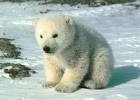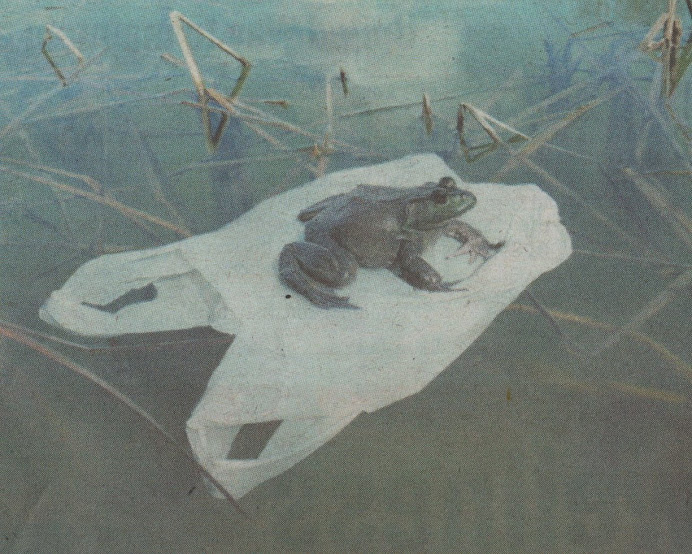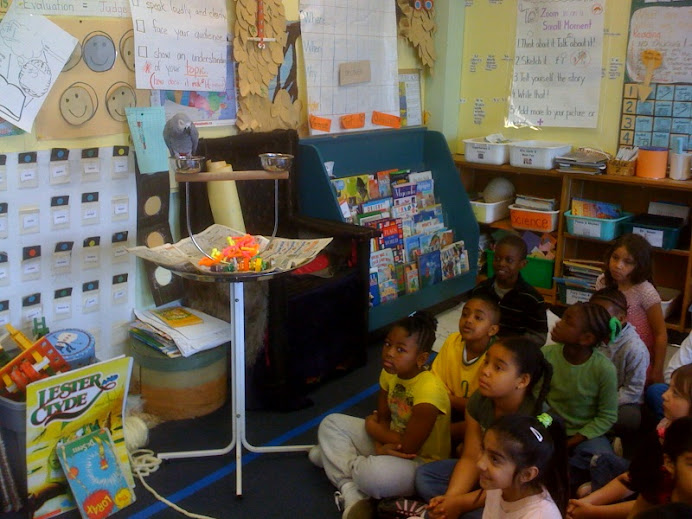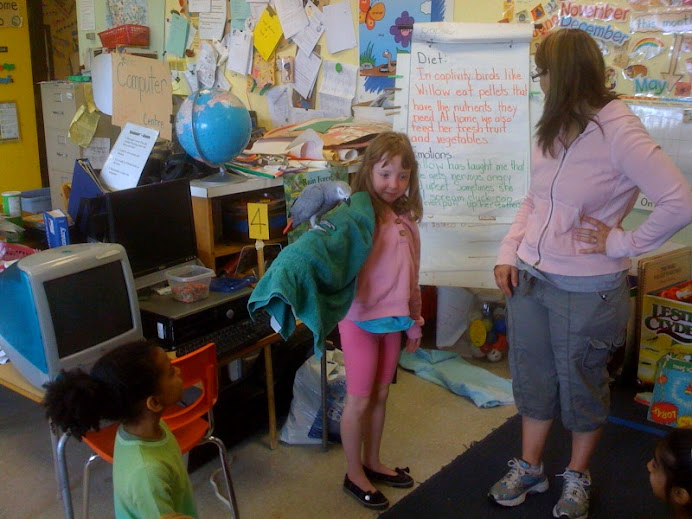Friday, June 19, 2009
Don't forget!
When was the last time you checked out the Room 106 Blog? Click on http://jrwilcox2.blogspot.com to see photos from Nancy's performance!
Awesome Field Trip!
Our trip to the Ontario Science Centre was incredible! We had a great time. You can see how much fun we had. Check out all the action at
Enjoy!
Tuesday, May 26, 2009
Great White Shark
Did you know that great white sharks they live in the cooler coastal waters of the worlds oceans. They hunt other fishes and animals such as seals. When they attack their eyes are covered by a protective shield. They swim very fast when hunting. They can grow to over 20 feet long and weigh up to 3 tonnes. The only predator a GWS knows is man.
Mountain Goat
Did you know mountain goats use their horns to protect themselves from predators (mountain lions, lynx, eagles). The young 'kids' learn from each other and especially the nanny goat. They eat grasses, fruits, vegetables and salt from clays and dirt's. The goats live in the western mountain ranges in North America. They can live 12-15 years in the wild and up to 20 years in captivity. In the spring their fur is a brilliant white and in the winter their fur turns to a whitish yellow.
Monday, May 25, 2009
African Grey Parrot
Did you know that the African Grey Parrot can live to be 50 years plus. They live in rain forests, mangroves and gardens in Africa. These parrots are the most intelligent birds and are often kept as pets all over the world. They communicate by screeching loudly and also can repeat human voices and other sounds around the world.
Bees
Did you know that if bees sting another animal they will unfortunately die because they loose their stinger. Bees communicate by dancing and buzzing around. Their predators are humans and bears and other sweet-toothed animals because their shelters get destroyed. There are many different types of bees living all over the world. Bees are very important to our world because they pollinate plants everywhere!
The Queen Angelfish
Did you know that the Queen Angelfish can grow to be 40 cm long and weigh up to 2.6 Kg. It gets its name from the speckled spots on its scales. It eats soft coral and small crustaceans. It lives in the western Atlantic ocean throughout the Caribbean. They also eat bacterias off of other fishes like a 'cleaning station'.
Thursday, May 21, 2009
Red Eyed Tree Frog
Did you know that a red eyed tree frog can jump up to 2 M between trees. They also eat small insects. The main predators of the red eyed tree frog are grass snakes and birds. They can be green, brown and grey. The frogs can grow to 3 inches. The four stages of their life cycle are 1. the egg 2. tadpole 3. metamorphosis 4. adult frog.
Elephants
Did you know that there are four types of elephants (Indian, African, Asian and Nepalesian). Did you know African elephants are the largest elephant. Elephants eat grasses , fruits and bark. An elephant can live to 50 to 70 years. My favourite part of my animal project was learning about their unique characteristics like the elephants in captivity. They can play soccer, paint pictures and play basketball. They also like to swim.
Wednesday, May 20, 2009
Hippopotamus
Did you know that a hippo when it opens its mouth it can eat one hundred or more fish at once. A hippo can live up to 45 years. They live in Africa (counties in east Africa, like Kenya). Hippos live in shallow lakes and rivers. All hippos are born in the water. They communicate by making grunting sounds and loud breathing especially when there is trouble around the young hippos.
Thursday, May 14, 2009
Chimpanzee
Did you know that they can stand on their feet. They eat leaves and sometimes eats monkeys. They eat ants by placing a long thin stick in an ant hill and then the ants crawl onto the stick and the Chimp then eats away. They can live to 40 years plus. They use tools like rocks and sticks. Chimps use many different types of facial expressions to communicate.
Dingo
Dingos eat rabbits, kangaroos, snakes and rodents. They live in Australia and Southeast Asia. They live up to 10 years. They can grow up to 70 lbs. Dingos live in family groups called packs. They are a very neat looking animal!
Friday, May 8, 2009
Cheetah
My animal is the cheetah. It lookes like a cat. It can run fast. It can run faster than an adult gazelle. It is the fastest runner in the world. It lives in parts of Africa. It eats gazelles, zebras. A cheetah is a mammal. KALIAH
Elephant
My animal is an elephant. It lives in Africa and Asia. It eats grass and leaves with its large body. SHAWNA
Giraffe
My animal is a giraffe. It looks like a long neck and it eats leaves. It has a lot of spots. It reaches up to the tree and their babies are so cute. It lives in Africa. SAORY
Horse
My animal is a horse. Horses live in every country. Horses eat grass and hay. Horses are brown and light brown and some are black and some are white. Some people can ride horses by sitting on the saddle. TCHISSOLA
Polar Bear
My animal is a polar bear. A polar bear eats seals. It lives in the actic. It likes to swim. It can swim after it lost half its body weight. KATELYN
Whale
My animal is a whale. A whale is a mammal. It lives in the water. It eats krill and small creatures. A whale swims fast and it jumps high like some dolphins. They can roll over like some dolphins too. They are bigger than me and bigger than a car. A blue whale is maybe the size of a parking lot. Their width is like a parking lot too. NATHANIEL
Baboon
My animal is a baboon. It has hair and it is a mammal. It lives in the jungle. It can jump and play. ALICIA
Wolf
My animal is the wolf. It lives everywhere. It eats deer and rats and many more. It likes to play. It can run fast if you bother them. They are dangerous. Their bites hurt. I just stay away from dangerous ones. JOSHUA
Mouse
My animal is the mouse. It lives in people's houses and in little holes. It eats cheese. It likes to steal cheese from other mice. It can run faster than other animals like people, and sometimes cats. IVY
Thursday, May 7, 2009
Butterfy
My animal is the butterfly. It lives in forests and jungles. They eat nectar. They like to fly around the jungle. It can fly and the other animals can't, except birds. First the mom lays eggs and caterpillars come out. Caterpillars eat lots of leaves. It goes in a cocoon and comes out and it is a butterfly. MIKAYLA
Snake
My animal is a snake. A snake is long and eats rats and mice. It lives in the forest. It likes to slither after animals. It can outrun a rat. It can eat a rat whole. It can eat frogs. LUCAS
Horse
My animal is a horse. It lives all over the world. It eats grass and hay. It likes people to ride it and it likes to jump. It is a mammal. It likes to whinny and neigh. CLEVAL
Gazelle
My animal is a gazelle. It is a mammal. It lives in Africa. It eats green grass. It has light brown fur and two antlers when it is a grownup. When it is a baby it has light brown fur with white dots, but no antlers. It can run almost as fast as a cheetah. It likes to run really fast. ALYSHA
Tree Frog
My animal is a tree frog. He is green, has red eyes and has suction cups on the tips of his fingers. He lives in the rainforest. They leap very high. JACK
Lizard
My animal is a lizard. It lives in the forest and sometimes in the city. It eats bugs and leaves. It likes to run. It can walk up walls. They are sometimes green and brown. Lizards are reptiles. MASSIMO
Animals Are Amazing
Welcome to our JR Wilcox Grade 2 IB animal blog! We are studying amazing animals and this blog will be used to describe and teach you all about how amazing animals are!
Monday, May 4, 2009
IB Animal Project
Our latest assignment is an IB Animal Project. Here are some helpful website links you can use for your research
http://www.linktolearning.com/grade2science.htm (this is the site that we use in the school library)
http://www.nationalgeographic.com/
http://www.wikipedia.com/ (your parents will have to help you read this one)
http://www.raz-kids.com/ (go to the bookroom where you can listen to books and read along)
iTunes has many great video podcasts about animals. In the left window of your iTunes browser you will see the iTunes store. Click on the store, go to podcasts, go to video podcasts, Science category, and search there. If you don't have iTunes on your computer you can download it for free from http://www.apple.com/ca/downloads/
http://www.linktolearning.com/grade2science.htm (this is the site that we use in the school library)
http://www.nationalgeographic.com/
http://www.wikipedia.com/ (your parents will have to help you read this one)
http://www.raz-kids.com/ (go to the bookroom where you can listen to books and read along)
iTunes has many great video podcasts about animals. In the left window of your iTunes browser you will see the iTunes store. Click on the store, go to podcasts, go to video podcasts, Science category, and search there. If you don't have iTunes on your computer you can download it for free from http://www.apple.com/ca/downloads/
Subscribe to:
Posts (Atom)


































































